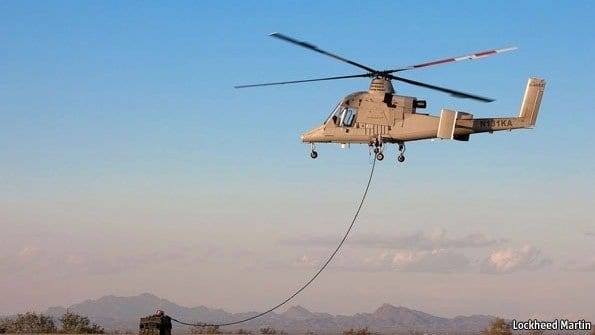After unmanned drones, pilotless helicopters are taking to the sky to deliver supplies to troops
UNMANNED attack aircraft, such as Predator and Reaper, have become a familiar part of modern warfare. But an army, famously, marches on its stomach, and campaigns can be lost as easily by a lack of supply as by a lack of firepower. That, combined with the increasing squeamishness of rich countries about taking casualties, is leading to the use of a new type of drone in the form of unmanned helicopters to deliver supplies. Pioneered by the armed forces, these hovering robots will also find civilian roles.
Two unmanned helicopters have been flying experimental combat missions delivering goods to American marine outposts in Afghanistan since December 2011. The project has been such a success it has twice been extended and may well run until September 2013. The helicopters in question are modified versions of the K-MAX, built by Kaman, an American aerospace firm. They are used in a number of military roles and in civilian jobs, such as logging and power-line construction, as a sort of airborne sky-crane cum delivery truck.
Strange bird
The K-MAX (pictured above) is a “synchropter”, with two sets of intermeshing blades, synchronised so as not to hit each other. It looks ungainly, but it is a robust system. The rotors turn in opposite directions to cancel out torque, the twisting action which requires conventional helicopters to use a tail rotor—a hazardous appendage. The modification for autonomous flight was carried out in a joint venture with Lockheed Martin, a big American defence contractor. By August the two K-MAXs had flown 485 autonomous sorties carrying over 900 tonnes of cargo.
The K-MAX was selected because it can carry over 2,700kg, which is more than its unladen weight. Unlike many large fixed-wing drones, which are flown under remote control by ground-based pilots, a modified K-MAX flies autonomously along a programmed course using GPS to navigate via specified way points. It can also be operated by remote control. The craft use a number of sensors, some of which Lockheed Martin is keeping mum about. These give the helicopter an awareness of its surroundings which is precise enough for it to land in total darkness. The American army is interested in adding a sophisticated camera to survey landing sites and spot potential threats. The camera could also help direct a helicopter from the ground and be used in civilian roles, like fire fighting or search and rescue.
The army has also suggested fitting some form of self-defence, like a gun which the camera could be used to aim. At present the K-MAX has no defensive systems, but Lockheed Martin says the helicopters could easily be fitted with armour, machine-gun pods or flares which could be fired as decoys to divert ground-launched missiles. But this would eat into its cargo-lifting capacity.
The unmanned K-MAX carries its cargo externally on a 25-metre cable. The helicopters are monitored as they fly autonomously to a forward operating base, where a marine controller on the ground takes over using a portable device to direct the drop. However, the helicopters can deliver a load to given co-ordinates without any human intervention. Jim Naylor of Lockheed Martin says the craft have been tested with radio beacons placed where the drop is needed. The K-MAX then delivers its cargo to within three metres.
via The Economist
The Latest Streaming News: Autonomous helicopters updated minute-by-minute
Bookmark this page and come back often
Latest NEWS
Latest VIDEO








